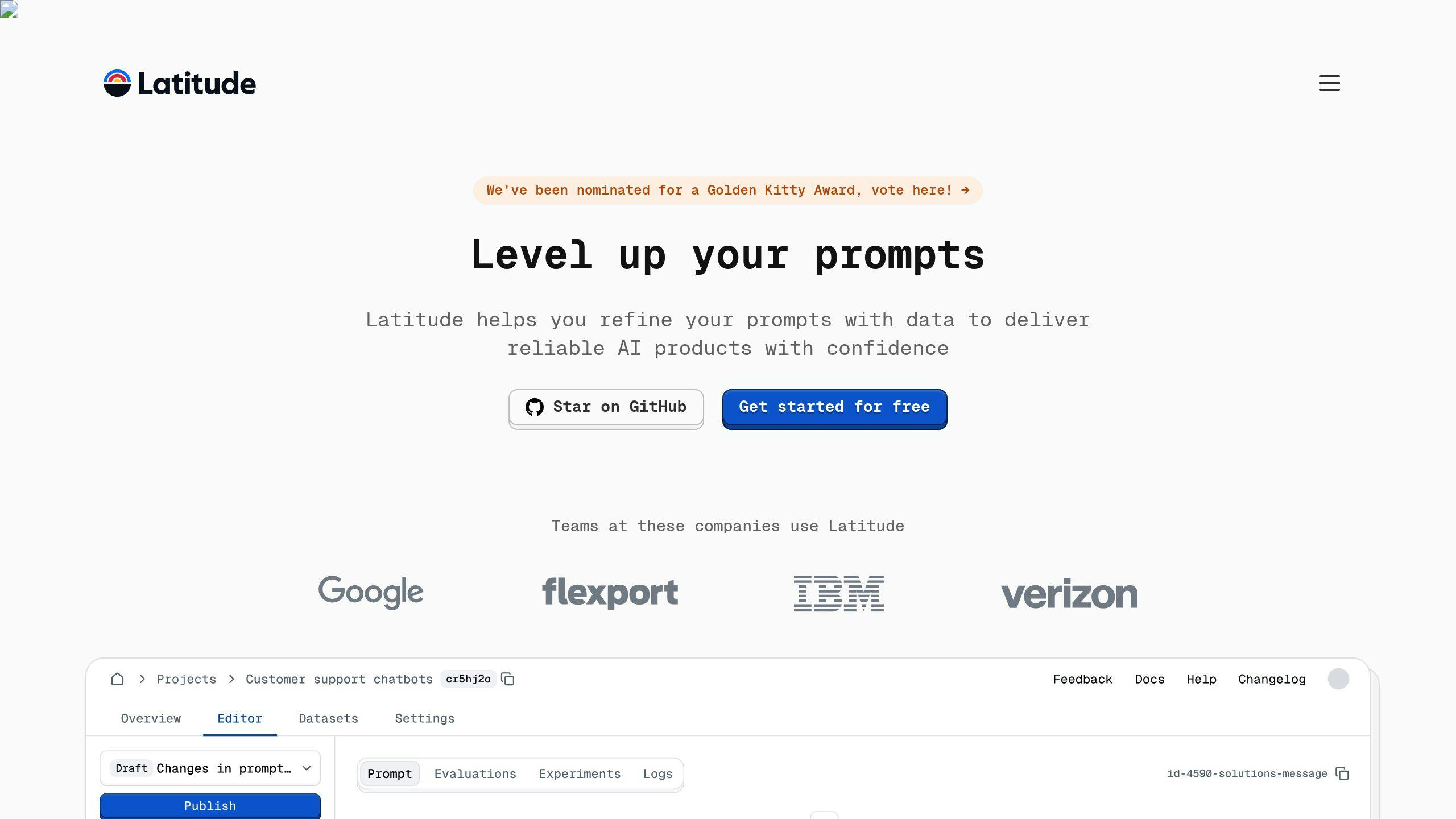Iterative Prompt Refinement: Step-by-Step Guide
Learn how to enhance AI outputs through iterative prompt refinement, focusing on clarity, feedback, and structured experimentation.

Iterative prompt refinement is the process of improving AI-generated results by tweaking and testing prompts step by step. Here's how it works:
- Start with a clear prompt: Be specific about what you want the AI to produce.
- Review the output: Check for accuracy, relevance, format, and completeness.
- Refine the prompt: Adjust based on feedback - add constraints, examples, or clarify terms.
- Test and repeat: Compare results, document changes, and gather feedback to improve.
Why it matters:
- Better outputs: Aligns results with goals.
- Fewer errors: Fixes issues early.
- Consistency: Ensures reliable results for similar tasks.
Tools like Latitude simplify the process by enabling collaboration, feedback sharing, and version tracking. Advanced techniques like chain-of-thought prompting and few-shot learning can further enhance results. Start simple, refine gradually, and test thoroughly for the best outcomes.
Understanding the Iterative Prompt Refinement Process
Key Concepts in Iterative Refinement
Iterative prompt refinement is built on two main ideas: improving through feedback and structured experimentation. The process involves reviewing outputs, spotting issues, and tweaking prompts step by step to get better results. Instead of relying on guesses, developers use real performance data to adjust prompts when outputs don't meet expectations.
Benefits of Iterative Refinement
This approach brings several practical advantages to prompt engineering:
| Benefit | Effect | Real-World Use |
|---|---|---|
| Better Outputs | Aligns results with specific goals | Reliable for production |
| Fewer Errors | Identifies and fixes problems early | Reduces surprises |
| Improved Control | Handles complex tasks effectively | Delivers precise responses |
| Consistency | Works well across similar tasks | Scalable for larger projects |
Challenges in Refining Prompts
Refining prompts isn't without its hurdles. Striking a balance between being specific enough for accuracy and flexible enough for varied tasks can be tricky. There's also the risk of over-refining, where too many tweaks lead to smaller and smaller improvements. Setting clear goals can help avoid this and keep the process focused.
For more advanced applications, the complexity grows. Methods like self-refine prompting demand carefully designed feedback loops to prevent repeating errors. This requires a solid grasp of both the model's strengths and the task's needs.
Tools like Latitude make collaboration and version control easier, helping to manage the challenges of refinement. While the process can be complex, following a clear and structured approach can simplify it and lead to better results.
Guide to Refining Prompts Step-by-Step
1: Creating an Initial Prompt
Start by crafting a clear and focused prompt that sets specific expectations. Use precise language while keeping the tone conversational. Avoid vague instructions and clearly define what you want the model to deliver.
For instance, instead of saying, "Write about electric cars", try: "Explain the three main advantages of electric vehicles compared to gas-powered cars. Focus on their environmental impact, maintenance costs, and performance metrics. Include specific data points where relevant."
Adding a role to the instruction can further refine the response. For example, "Act as a financial analyst" guides the model to tailor its output to that perspective. As Vince Lam puts it:
"Prompt engineering is about conditioning them for desired outputs."
2: Assessing the Output
Evaluate the generated content methodically. Look at key areas like accuracy, relevance, format, and completeness:
| Aspect | Key Considerations |
|---|---|
| Accuracy | Verify factual correctness; include fact-checking instructions if necessary. |
| Relevance | Ensure the response aligns with your objectives; clarify goals in the prompt. |
| Format | Specify the desired structure and presentation. |
| Completeness | Check if all required elements are included to meet expectations. |
Identify where the output falls short, such as misinterpretations or missing details, and note areas for improvement.
3: Adjusting the Prompt with Feedback
Refine the prompt based on your review. If the response is too lengthy, specify a word or sentence limit. If it's lacking in detail, include examples or clarify what level of depth you're looking for.
"The more details you provide, the more targeted results you'll get - without adding unnecessary details." - Atlassian Work Life
Key adjustments to consider:
- Add constraints like word count or format.
- Provide examples to illustrate the desired outcome.
- Clarify terms that might be open to interpretation.
- Specify the level of detail or depth required.
4: Testing and Repeating
Track your changes, compare outputs, and gather feedback to fine-tune the results. Tools like Latitude can help teams document iterations, evaluate outputs, and share insights efficiently.
Steps to follow:
- Document Changes: Keep a record of each prompt version and its corresponding output.
- Compare Results: Analyze new outputs against earlier iterations to identify improvements.
- Gather Feedback: Collect input from stakeholders to ensure the prompt meets its goals.
Strike a balance between refining prompts and maintaining efficiency to avoid unnecessary effort. Once you’ve mastered the basics, you can explore advanced techniques to further improve the results.
Advanced Methods for Prompt Refinement
Once you’ve got the basics of prompt refinement down, it’s time to explore advanced methods. These approaches take the iterative refinement process to the next level, offering strategies to get more precise and dependable results from LLMs.
Chain-of-Thought Prompting
This method helps LLMs tackle complex tasks by breaking them into logical reasoning steps. It ensures a more structured approach to problem-solving. Research shows that using self-correction prompting with GPT-4 can boost its accuracy by 8.7% on certain tasks and improve code readability by 13.9 units [4].
Few-Shot Learning in Prompt Engineering
Few-shot learning involves adding 2-3 examples directly into the prompt. These examples demonstrate the tone, format, or context you’re aiming for, making it easier for the model to follow your intent. When paired with chain-of-thought prompting, this technique has been shown to improve performance in sentiment reversal tasks by 21.6 units [4].
"Prompt engineering is not a one-size-fits-all approach. Depending on the task, different techniques can help refine and optimize the way prompts interact with large language models (LLMs)." [3]
Using Latitude for Prompt Engineering

Latitude’s open-source platform simplifies the process of prompt engineering. It allows for collaboration, systematic testing, and the integration of advanced techniques like chain-of-thought prompting and few-shot learning. This makes it easier to develop and deploy LLM features that are ready for production.
Best Practices and Mistakes to Avoid
When refining prompts, it's crucial to stick to effective practices and steer clear of common pitfalls. This ensures better results and helps avoid unnecessary complications.
Effective Prompt Refinement Practices
For effective prompt refinement, focus on clarity and structure. Use straightforward language to guide the model toward your goals. Studies show that breaking down complex tasks into smaller steps can greatly improve performance [3].
| Practice | Benefit |
|---|---|
| Clear Context Setting | Helps the model produce accurate outputs |
| Constraint Definition | Keeps responses focused and structured |
| Systematic Testing | Ensures consistent quality through trials |
| Expert Collaboration | Enhances accuracy with domain expertise |
For example, instead of saying "write a short description", specify "create a 50-word product description highlighting key features." This level of detail leads to sharper and more relevant outputs.
Common Errors in Prompt Refinement
Even experienced developers can make mistakes when refining prompts. A major issue is adding too much information or using technical jargon, which can confuse the model and reduce output quality [3].
Frequent mistakes to watch for:
- Ignoring Edge Cases: Overlooking rare scenarios can hurt performance when unusual inputs arise.
- Skipping Feedback and Testing: Failing to gather user feedback or test revisions thoroughly often results in subpar outputs.
Thorough testing is essential. Each prompt revision should be evaluated against set criteria to ensure it meets your expectations. Research shows that regular testing and fine-tuning can dramatically improve both accuracy and relevance [3].
Using collaborative tools can also simplify the process by tracking changes and organizing feedback. By following these practices and steering clear of common errors, you'll refine prompts more effectively and achieve better results.
Conclusion and Main Points
Key Takeaways
Refining prompts for large language models (LLMs) is an ongoing process that blends clarity, testing, and feedback to improve outcomes. Thoughtfully crafted prompts lead to better performance across various use cases [1][2]. Tools like Latitude simplify teamwork, making it easier to refine and implement production-ready features.
"Effective prompt engineering is usually not a static, one-time interaction. It's a learning process where testing and refining your prompts is essential."
This insight from Francesco Alaimo, team lead at TIM, underscores the evolving nature of prompt engineering and its role in achieving optimal performance [2].
Moving Forward for Developers
Improving prompts involves careful testing and iteration [3]. Start with straightforward prompts, then gradually add complexity while keeping track of changes to measure progress. Collaborative tools can help teams work together efficiently toward the best results.
"When you build applications with large language models, it is difficult to come up with a prompt that you will end up using in the final application on your first attempt."
Youssef Hosni's comment highlights the importance of patience and persistence in this process [1]. By following these principles and using collaborative tools, teams can create and maintain LLM features that meet production needs effectively.
FAQs
How can iterative prompting help refine AI-generated results?
Iterative prompting improves AI-generated outputs by systematically tweaking and testing prompts until the desired results are achieved. This method ensures that the outputs align with quality standards and meet project goals [1][2].
"Effective LLM prompting is an iterative process. It's rare to get the perfect output on the first try, so don't be discouraged if your initial prompts don't hit the mark." - Peter Hwang, Machine Learning Engineer at Yabble
The process involves reviewing the outputs, making adjustments based on feedback, and testing repeatedly. Tools like Latitude make this easier by allowing teams to document changes, share insights, and fine-tune prompts for production-ready results.
"Any prompt to the LLM(Large Language Model) cannot be a perfect prompt in one shot." - Aanshsavla, Author
This strategy works especially well for creative tasks or projects with precise requirements. By combining structured evaluation with collaborative tools like Latitude, teams can simplify the refinement process and produce consistent, high-quality results across various applications [1][2][3].
